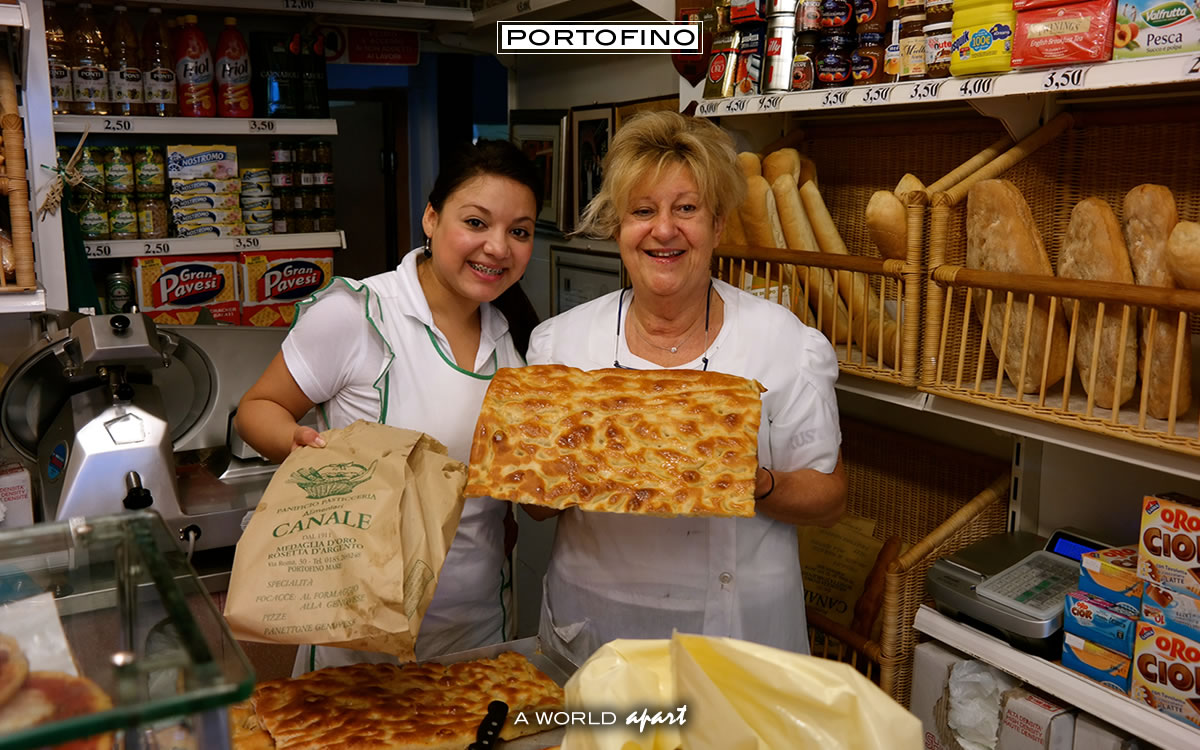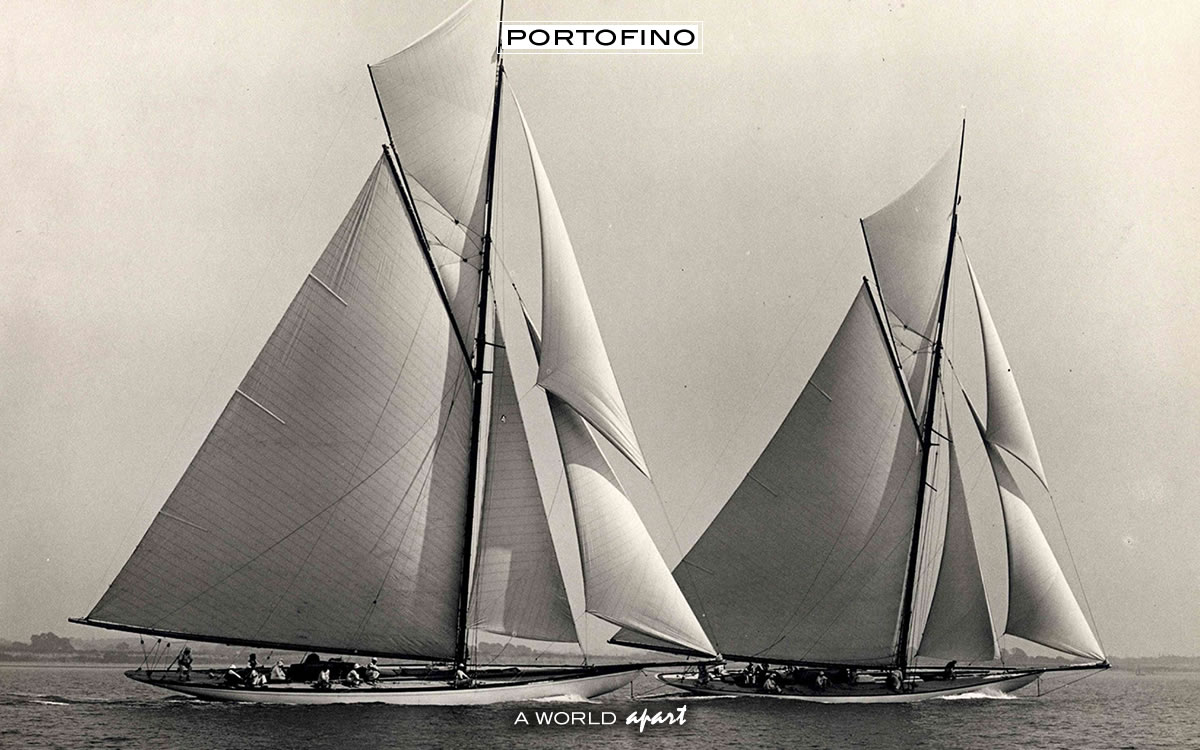
La lavorazione del pizzo a Portofino
This category in Portofino had a long period of prosperity, at the beginning of the second half of the 19th century dragged along at alternate stages, because of war events. There was a new economy as time went by, which gave rise to a change in economic activities that gave well-being to the Village. After the annexation of the Genoa Republic to the Sardinia Kingdom, a remarkable number of foreign families who represented their Countries at Genoa, discovered Portofino and, one after another, they established an international residential colony in Portofino: with much attention, they jealously preserved their property handing it down from one to another for about a century.
The Italians were able to put foot there only after the Second World War. At the first “appearance” of the residential constructions, who gave orders to start work painting and preparing the foundations to build the houses was an artisan called Benedetto Gardella, said to be “Beneitu”, whom we have already spoken about in the previous chapter. This important man, besides other things, was very clever at constructing stone walls with the stones of Portofino, because he had a very good knowledge of the “cutting the stone” system and choosing the right stone: this was not an easy operation because they were made of “pudinga”, a mixture of very hard pebbles.
My mother told me how he prepared the ground of Odero castle, the villas belonging to Basso and Bocciardo at Paraggi. He died in 1920 after being hit on the spine by a mass of stones, after Consigliere his brother-in-law, continued building the villas. From the first pioneer, that is Consul Brown, who transformed the fortress into civil houses, many others followed his example giving the start to a real local economy: only one person managed to become part of the “foreign character” of the building industry, with a delicate territorial structure for the introduction of new buildings.
The name of this person was G. B. Consigliere, originally from Pieve Ligure who, in the second half of the last century walking from Ruta to Portofino once a week proving that work was scarce, realized thata new age was to start at Portofino. Consigliere built Villa San Giovanni, transforming it from peasants’ houses to residential villas owned by Herbert Carnarvon, who purchased from Prato most of the Peninsula. A second important construction was the Sea Lighthouse, situated on the point of the Cape. This building was inaugurated in 1900 and gave great prominence to the community; it was an event that indicated the precise point of the port for who was arriving by sea.
The day of inauguration was celebrated with the presence of the marine authorities and also the citizen’s band.

The famous Focaccia ligure
A third construction, for Mr. Benazzi, was Villa Aranci, after became the property of Mr. Fresco Repetto Benvenuto: this cottage was the home for more than half a century of the writer Salvator Gotta, who brought a lot of international fame to Portofino. Another building that was transformed from a peasant’s house to a residential villa was the Signorile villa in front of Castle Brown: Cesira Benvenuto’s aunt sold the San Giorgio Castle, owned already by the natives of Portofino, to Mr. Licce, an Englishman who was an appraiser of Portofino, he then sold it to Mr. Mumm. Licce built the San Martino villa and transformed the house situated on the isthmus into a villa: both of the houses, San Martino and San Giorgio had the front part done in yellow and blue stripes down to the sea, a particularity that some older people remember today.
After, Consigliere built for the Basso family, an old name of Portofino, the San Sebastian villa (today Emanuelli), the Aurelia villa (today Croce), the Belvedere villa (today Corbetta), the Delta villa and the Piccolo hotel belonging to the Bruzzos and the Vexinaro villa for the german composer of music, Crem. In 1912 Baron Mumm bought from Licce the San Giorgio house and he transformed it into a castle, building the turret and all the parts situated on the rocks in open sea. In 1913 he built for Senator Odero the castle above Cajega, with the project of the famous architect Copede, after, he built for the Trossis the Bianca villa on the Peninsula, he also transformed a check-point turret house into a civilian house with access to the Battaglia Dock, today the home of Berlusconi, together with two other small buildings towards the Cape.
He also built for another Englishman, Mr. Bunz, the house that goes down to the Olivetta beach that, after the death of Bunz, was left in his inheritance to a peasant: he transformed it into a civilian house the Castelletto, that had a sight-seeing point from Saracenic times which was used to alert the coast of Tigullio using fire: this house was the home for a long time of the well-known English journalist, Clifford. He totally refurbished the Valdameri villa (after Mondadori), as well as building the Buon Accordo villa for Mrs. Mumm, sister-in-law of the Baroness of San Giorgio castle, and the Algaiola villa at Paraggi, for the Trossis.
He also built for Minuto the “connection” between the houses on the Marconi Quay: a very interesting work of amendment, but the older people of Portofino told Minuto that “he was shortsighted”, Minuto was at that time mayor of Portofino, adding that the money invested in the buildings called Palingenesi, would be “thrown down the drain”. At Fondaco Consigliere builds different constructions of remarkable importance in the historical center, like the construction for depositing building equipment and houses for the most trusted employees. Then he built the private slaughterhouse for the Bennatis and again for Rocca refurbished all the houses above “Caffe Excelsior“. I’m not mentioning the constructions in the historical center or in the Quay because they are not so important, but they were, however, jobs carried out with “Ligurian character” and with good taste, without offending the characteristics of the environment: you can compare this through the photos. He undertook the work contact of the road from the parish church down to the “Carriage Square” connecting to the port, as well as the work contracts for the port’s dock, carrying out outlines and doing marine maintenance in general.

Regatta in front of the Portofino Lighthouse
This worker who had arrived from Pieve married a Giuffra called Maria, a family that originated from Fontanabuona valley who honored Portofino by their hard work: they had four children, Caterina and Teresa, Giovanni and Paolo, called “Ninin” who followed their fathers profession with ability and perseverance; “Ninin” “gave birth” to `Carillon” in far off 1930 and the sisters administrated contemporaneously the building contractors. The Consigliere firm was a true school of bricklayers that, for some time remained the economical ancillary of the Village: from this pioneer of the new economy, that contemporaneously turned into tourism, many “sons of artists” began their adventures becoming artisans, I remember their names from my generation. Starting from Gerolamo Viacava, who was his favorite pupil, Carmelo Paulillo said “Sin”, Domenico Sacco called Mingo”, the faithful Gerolamo Devoto, and Enrico Indaco: they all worked for themselves but were always controlled by the old man, who wasn’t at all jealous of his pupils and continued helping and advising them, dealing with architects and engineers of an international level. At the same time, other inherent professions arrived in the building economy, like Nunzio Giardina, that is the blacksmith “Moro”, who opened a workshop working with iron together with his children Giovanni and Guido, with their art, furnished the most fascinating villas of Portofino; the young Giovanni “Dido” Rastelli had the joinery, but unfortunately his children didn’t continue their father’s profession, other expert workers improved their abilities to break the rocks and building stone walls.
I rememberthe names of Cesare Casazza and Eugenio Arata who worked first for Benedetto Gardella, an old bricklayer who carried out different important work, including many walls on the road from Paraggi to Portofino, or rather the new motor road, as well as the walls around the villa Prato and Sabaino. Other boys that have been pupils of these personalities have undertaken, with the event of tourism, new jobs in line with the times, like gardeners, keepers, caretakers, and land administrators plus other jobs inherent to the new economy. Consigliere’s cleverest pupil was Gerolamo Viacava who, following the footsteps of his teacher, built new villas like Villa Makale, villa Rosa, the Vitrale, the second Villa Makale of Bortolotti and other important works of restructure in the historical center. The last “facade artist”, who specialized in the sandstone technique, was Emilio Vargioni called “Nittu” or “the Professor”, a pupil of the famous painter Franceschetti: he wasn’t born at Portofino, but he was considered a native of Portofino by “adoption” for his “artistic merits”.
Today at Portofino we can find very good artisans that continue to work with the same dedication and love as their ancestors, who have always carried out the building constructions in conformity with the art of nature: Mauro Ramasco and his son Paolo, who are very esteemed people in the Portofino environment, then Giuseppe Viacava said to be “Piccio”, an artisan pupil of Consigliere, a quiet man but on the whole very esteemed by our quests, consequently he is never without work; always helped by his children Roberto and Alessandro; lastly we remember the brothers Mino and Gerolamo Viacava that, proposing other economical times, are changing their activity also in the shops. Other firms have built other buildings in the Village, always respecting the “local Ligurian character,” like the Poggis and the Perugis, who had built the Finollo’s villa and the Foligno’s villa in the thirties; the Poggis have built the council houses of IACP: then the firm Solari of Chiavari, built the building said to be “dei Leoni”, the Bianco cottage, Benvenuto’s garage, and the “Teatrino”, called “dei Balilla”.
After the war, important public works were carried out: the firm Iacassio built the church of San Giorgio destroyed by war events, the commune council houses in Fondaco Street, Gimelli’s house in Fonadaco, the commune aqueduct with its respective cisterns; not long after the Poggis built the villa Harrison and the villa Toie at Vexinaro. For a long period of time, other firms went backward and forward to Portofino to carry out “debatable” works which we will speak about in another chapter. A memory, therefore, goes in favor of the Consigliere family, whose founder gave to Portofino not only work and an ancillary economy up until the Second World War, but also well-being to the families, giving the example that every man, with determination and goodwill, can start many activities in Portofino, behaving honestly and sincerely. I want to say, stone the crows!, that on the temple ofSan Giorgio church people have been named that have contributed towards the fame of Portofino in the world, but the people who have given honor and art to Portofino to a point that architectural and Merchant Navy books have spoken about them, have not been nominated: I refer to the name of G. B. Consigliere and the name of Captain Sanguineti. (Thanks to Giovanni Carbone).
Portofino, a World apart.


